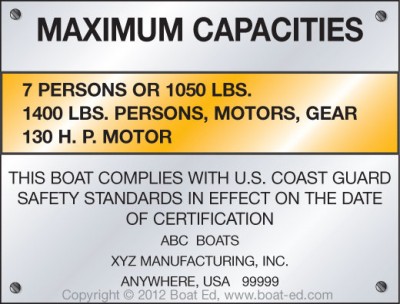
When you’re planning that perfect outing on the water, put boating safety at the top of your list by knowing how much weight your boat can safely handle.
Boats loaded beyond their capacity with gear and people are more difficult to control and can capsize more easily. Plus, in many states, it’s a violation to exceed that stated capacity.
Prevent overloading your boat by following these simple steps:
Look for a capacity plate near the operator’s position or on the transom of the boat. Federal law requires single-hull boats less than 20 feet in length must have a capacity plate. In addition, the National Marine Manufacturers Association (NMMA) requires a capacity plate on all boats less than 26 feet to qualify for NMMA certification.
- This plate will tell you the maximum weight capacity and/or the maximum number of people that the boat can carry safely in good weather.
- You should not exceed either the stated maximum weight capacity or the maximum number of people.
- Maximum weight is the combined weight of passengers, gear and motors.
- Boat owners’ manuals and manufacturers’ warning decals are other places to consult for information on capacity and maximum number of people a boat can safely accommodate. Make sure you never exceed the capacity recommendations.
Learn more by watching this video about boat capacity below.
httpv://youtu.be/V5G47Ax4UEg
On boats with no capacity plate, such as personal watercraft and sailboats, all you need is some simple math to calculate the number of people (weighing an average of 150 lbs. each) the boat can carry safely in good weather.
Number of people = boat length (ft.) x boat width (ft.) ÷ 15
For example, for a boat 18 feet long by 6 feet wide, the number of persons is 18 times 6 (or 108) divided by 15, which equals seven 150-lb. persons (or a total person weight of 7 x 150, or 1,050 lbs.).
Another consideration to help keep you safe on the water is making sure your outboard motor doesn’t exceed the boat’s maximum horsepower rating. On outboard motorboats, the capacity plate will display the recommended maximum horsepower rating of the boat.
Before you cast off, make everyone on board is wearing their life jacket, and that they wear them the entire time they’re on the water.
You can learn more about boating safety by taking an online boater safety course at www.boat-ed.com . The training offered at this site is approved by the state agencies responsible for boating safety education, and it’s the same material that’s taught in the classroom.
Studying at boat-ed.com is free. Those who must be certified before they can buy a boating license pay a one-time fee, which is due only if they pass the test. Students can take the test as many times as they need to pass it. Online boater safety courses are available in participating states, so visit www.boat-ed.com to take a course specific to your state.
 Your Privacy Choices
Your Privacy Choices
 The
The